CELEBRATING 91 YEARS OF A LIFE IN MOAB, THIS WEEK (September 22)
As I get older, the world seems far less interesting than it once was. I constantly hear the cry for more “diversity,’ but from where I stand, it seems like just the opposite is happening. Regardless of race, color, creed, or gender identity, the world looks a lot more—what’s the right word? — homogenized? Everyone has their noses buried in a cell phone. Social media controls our thoughts and actions—indeed our lives. Few under 50 know much history–not world history, or American history, or even their own. Many people alive today are unaware of anything that happened before they were born. They don’t hate history; they simply don’t know it exists.

It’s the same with ‘places.’ So much of this country, the ‘developed’ parts of it at least, looks exactly the same. The blandness and the banality of it is overwhelming. And yet few of us remember how it was; it’s been like this for so long that hardly anyone under 50 even notices. North Avenue in Grand Junction looks just like Menaul Blvd in Albuquerque, which looks just like Shelbyville Road in Louisville, which looks just like Maize Road in Wichita, which looks just like…I could go on and on. But what’s the point?
Besides, I’m here today, NOT to complain about the lack of uniqueness in this bland culture of ours. but to celebrate it when we find it. In this case, as the title suggests, we can gratefully report of a place where “God broke the mold,” in Moab, Utah.
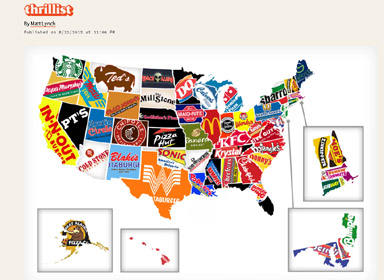
God created Karl Tangren, scratched His chin and either said, “This kid is too amazing to ever duplicate,” or concluded, “I don’t think the world could handle TWO Karl Tangrens at the same time.” My guess is —it’s a bit of both. One thing’s for sure…
There’s only one Karl Tangren.
We don’t get to choose where we enter this world, but Karl Tangren was born in the right place at the right time. You could say his timing was perfect. He landed on Planet Earth via Moab, Utah on September 22, 1931. He lived with his family in a little house on the west side of Main Street, between 100 and 200 North. It’s about where the Love Muffin Coffee shop operates today. In 1931, the streets weren’t paved and cottonwoods shaded most of Main Street. From their front porch, the Tangrens could see the red cliffs on the east side of town, and beyond them, the La Sal Mountains.
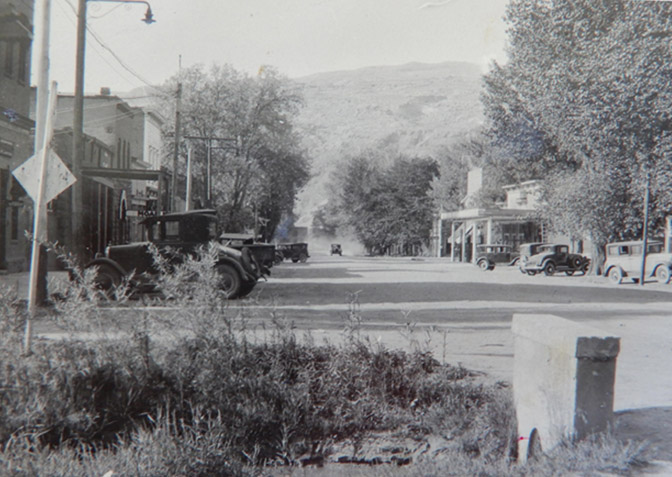
Karl was one of ten kids —seven boys and three girls — and I’m not sure where he fell in the pecking order. His older brother Claire was born in 1924, and was the 4th Tangren baby to arrive, so Karl may have been one of the last Tangren kids to see the first light of a Moab morning. From other interviews he has given over the years, Karl’s childhood sounded idyllic. He explored the canyons and mesas around Moab, and hunted and fished on the Colorado River and up in the La Sal Mountains. He knew about some caves high on the sandstone cliffs north of town, near the “Big G.’ and sometimes spent days up there. Moabites could often see the glow of a campfire high above the little town and would wonder if it was Karl, or one of the other boys who knew how to make the best of a free roaming childhood.
In an interview with former Times-Independent reporter Laura Haley, Karl explained that, “Life was much simpler back then. We made our own recreation.” There were no zip lines or climbing walls, or organized adventures. Karl and his brothers and their pals made it up as they went along. Nothing is more exhilarating to a kid than the taste of freedom.
But all that independence and that precious, wild and wooly connection to the natural world came to a sudden screeching halt when Karl’s parents decided to break up. His mom took the five youngest, including Karl, to live in Provo, Utah. He was enrolled in school there but he hated every moment of it. From the day he arrived in Provo, he was plotting his escape. Finally, three years into his urban imprisonment, Karl ran away, hitched a ride back to Moab, and never left. Other than that three year jail term (Provo boasted a population of 20,000 at the time—way too many for Karl) , Moab has always been home.
In the interim, his dad had remarried and set up a cafe, next to the little house where Karl was born. They called it Fern’s Cafe and for decades it was a central gathering spot for Moabites. It would also play a role in Karl’s future. Fern’s was a lot like the other cafes that came to Moab later and have also since vanished, like the old Westerner Grill. Fern’s was always open, sold gas, and even had a few tourist cabins out back.
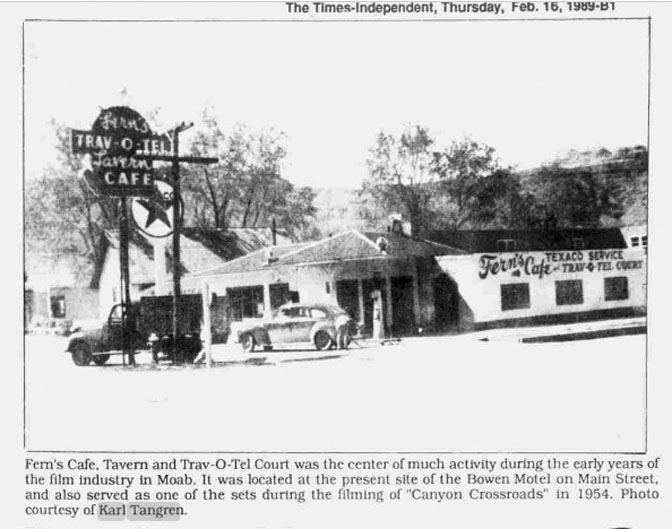
These were lean times. The country was just coming out of the Great Depression and World War II was in its third year in 1944. Radio reception was poor during the day, but Moabites could find stations easily after sunset. Karl loved the old radio programs like the Lone Ranger, but he followed the news of the war like everyone else. He made a living any way he could, working at Fern’s, pushing cattle —whatever it took to stay afloat.
Karl had been working with cattle since he came back to Moab in the mid-1940s and it’s a vocation he would stay close to for decades. And he loved horses, so cowboying was the job he could fall back on. But like so many other Moabites, and folks who lived in small, isolated, economically depressed communities across much of the American West, you had to be creative and willing to work dawn to dusk. You had to take what you could find and often you had to invent your own job.
The uranium boom hit Moab in the early 50s after Charlie Steen’s discovery and the town went crazy with boom fever, but Karl was never interested in staking claims or doing any prospecting. But he could handle the big ore trucks and for much of the 50s Karl hauled ore out of the Excalibur Mine in Mineral Canyon. It was a living, but he always had his cows too. He knew the canyon country better than anybody alive and even pioneered some of the trails that are still there today. He knew where the river crossings were and he knew how to move the cattle off the White Rim and the Island-in-the-Sky Mesa, and into the high country. It was the life he loved… and was meant to live.
But Karl was always looking for ways to increase the family income. In those days, before government red tape and the generally officious nature of just about everyone, it wasn’t that hard to start your own business. If you had some capital to invest and were willing to bust your butt to succeed, the door was open to all kinds of possibilities. In 1961, Karl started the first Maverik convenience store and gas station on Moab’s north end. He ran it for a decade and the deal he put together with his partners was all done on the strength of his handshake. It meant that much then. (not sure a “fist bump” would measure up now).
But in 1967, Tangren’s life turned in a different and entirely different direction. Fifteen years earlier, Harry Goulding, the owner of the trading post in Monument Valley, brought famed film director John Ford to Moab. Ford had fallen in love with the Monument Valley area a decade before and had shot numerous Westerns there. Now Goulding suggested Ford visit another scenic gem— the best kept secret in the American Southwest. A sleepy little town called Moab, Utah.
Ford visited the office of Moab’s Times-Independent publisher Bish Taylor. Taylor introduced Ford to his good friend George White, and the rest is history. Ford was mesmerized by the landscape and immediately committed to shoot his next film “Wagonmaster” in the Moab area. Much of the film was shot in Professor Valley and along the Colorado River. It was the beginning of the “film industry” in Moab. George White and Bud Lincoln (mentioned in an earlier Zephyr Extra about the Prospector Lodge) took an active role in bringing Hollywood to Moab. They created the Moab Film Commission and the number of movies shot on location in the Moab area started to rise. For George and Bud and many others, this seemed like the perfect industry for Moab. The film companies came to town, spent incredible amounts of money, paid good wages to those who worked on the films, and then they left. Many locals even secured bit parts as extras.
Karl had wanted to get into the film business himself, but needed to join the Teamsters, and had been unsuccessful. But in 1967, Paramount Pictures brought their production company to Moab to make the film “Blue.” It starred Karl Malden and Terrence Stamp and was shot at many locations around Moab, including Professor Valley, Seven Mile Canyon, and the Sand Flats. The director was looking for an old army truck to use in the movie and Karl Tangren just happened to have what they were looking for. So Paramount leased the truck from him, but also let Karl drive the truck in the scenes where it was used.
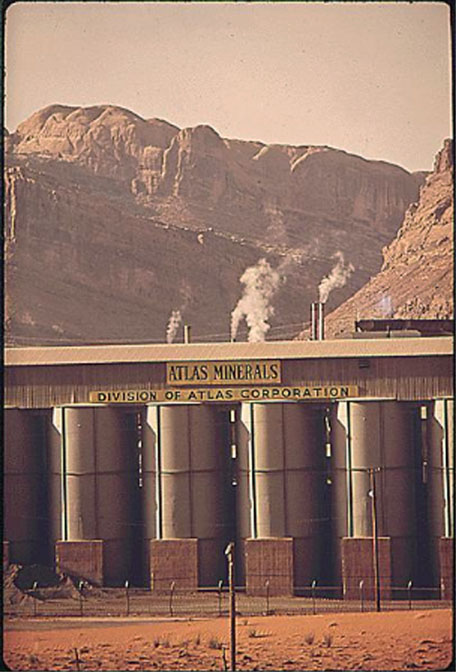
He could have worked even more hours, but Karl was employed at the UTEC mill, Charlie Steen’s uranium reduction plant north of Moab, and couldn’t get off work. For a man who had spent almost his entire life living outdoors, and who was happiest on a horse in the red rock country, working at the vanadium plant was not Karl’s favorite way to make a living. After his experience working on “Blue,” he quit the mill job and decided he would never work for anybody again— unless it was a movie. He told reporter Laura Haley in her interview for the Times, “I worked on the film for nine weeks and made more money than I did working nine months at the mill.”
Karl would be deeply involved in the Moab Film Commission for the next 51 years and served many of those years on its board of directors. Karl’s laid back personality made him the perfect liaison man with both the film people and the community. Karl was the MFC’s public relations man and when George and Bud both decided to retire, Karl’s responsibilities increased. He became responsible for generating the marketing money to promote Moab via local business contributions. And who could possibly say ‘no’ to Karl Tangren? In 1992, the MFC awarded Karl a “Special Achievement Award” for his years of dedicated service. He even managed to secure some ‘extra’ roles for himself in numerous films over the years. And Fern’s Cafe’, the restaurant his father started, was often a gathering place for the visiting film crews and casts. It was even used as a set in the 1954 film “Canyon Crossroads.”
*****
But Karl’s first love was always the life of a rancher. And it was in that role that he and other rural Westerners first came to clash with agencies of the federal government. Until the mid-60s, the management of federal public lands in the West was pretty loose. The Taylor Grazing Act of 1934 was the government’s first attempt to manage the use of those lands for cattle. But to a great extent, Southeast Utah was “The Land the World Forgot.”
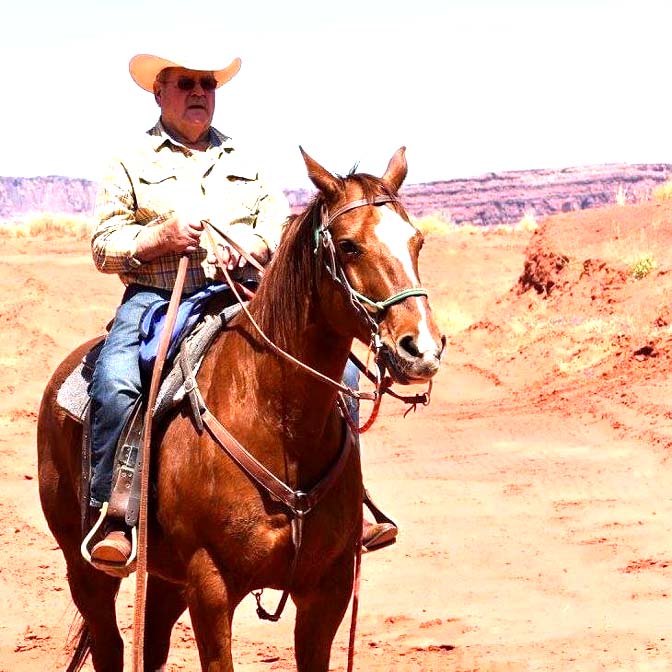
More than two-thirds of the acreage in southeast Utah is controlled by the federal government. To compensate the states, it gave sections of land to these states to administer as they saw fit. . In Utah, the result was a checkerboard of sections, each a square mile, and administered by the Utah State Institutional Trust Lands Administration (SITLA). Its obligation and goal was to use those lands to generate revenue for the state’s school system. In the 1950s, SITLA leased a section of land at Anderson Bottom on the Green River to Ray Tibbetts, a lifelong resident of Grand County. Ray, in turn, sold his lease to another Moab lifer, Ralph Miller, who turned it over to Karl. Karl developed a spring there, (still named Karl Tangren’s Spring) and built several structures. He loved the land at Anderson Bottom and because he had invested so much in that section, he figured he’d be there for a long time.
But during the early 1960s, the Department of the Interior and the National Park Service were pushing for the establishment of Canyonlands National Park. It was a controversial issue for most locals and the population was divided between those who thought the increased tourism would be an economic blessing, and those who feared the park would eliminate other economic options like mining and ranching.
There was another change coming, that caught Tangren by surprise. The Park Service and SITLA arranged what would be the first of many land “trades.” The Park Service wanted to incorporate state lands that were within the boundaries of the park. In exchange the federal government would give SITLA an equal amount of land it controlled that SITLA thought might be more profitable— usually lands with high potential for mineral extraction or oil and gas development. Karl’s lease expired on December 31, 1966, but when he secured the lease, it never occurred to him that it wouldn’t be renewed. The creation of Canyonland changed all that.
Karl was notified to vacate the premises and remove all his improvements by a certain date or face heavy fines. As one would expect, most locals sided with Karl and letters to the Times-Independent about the “land steal” came fast and furious. Finally, the new superintendent, Bates Wilson, replied. He had been Arches’ boss for 15 years and had always enjoyed a good working relationship with the locals. At the very least, they respected him for his candor and honesty. He never felt like a typical government bureaucrat to them. But Bates also had to defend the decision. In his letter to the Times, his response was pretty blunt.
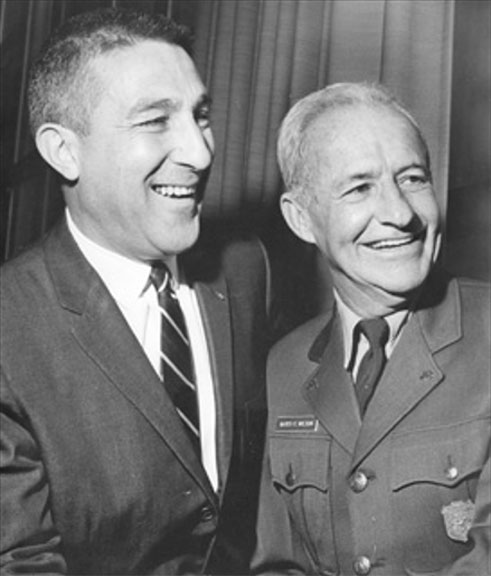
Wilson noted that on January 25, the State exercised its right to exchange more than 4000 acres of land to the federal government, including the Anderson Bottom section. “We wish to underscore,” Wilson advised, “that Mr. Tangren had a lease with the State of Utah; that he held no contract of any kind with the National Park Service.”
Karl had pleaded with the NPS to at least compensate him for the cost of his improvements, for “his time, money, and energy,” as Bated noted in his letter. SITLA had already rejected Karl’s request and now Wilson added, “…though we are sympathetic to his appeal, it is not within our province to make financial settlements which are the responsibility of the state or lesser governments.”
Bates added, “It is to Mr. Tangren’s credit that he has remained courteous and cooperative with the National Park Service in Moab…this is the type of spirit and public cooperation the National Park Service is privileged to enjoy in this area.”
The NPS extended Karl’s deadline to remove all of his personal items from Anderson Bottom, but it still left a bad taste in the mouths of many locals. It was just the beginning of the land management conflict and debate between the local governments of Western states and the federal government that continues to this day.
*****
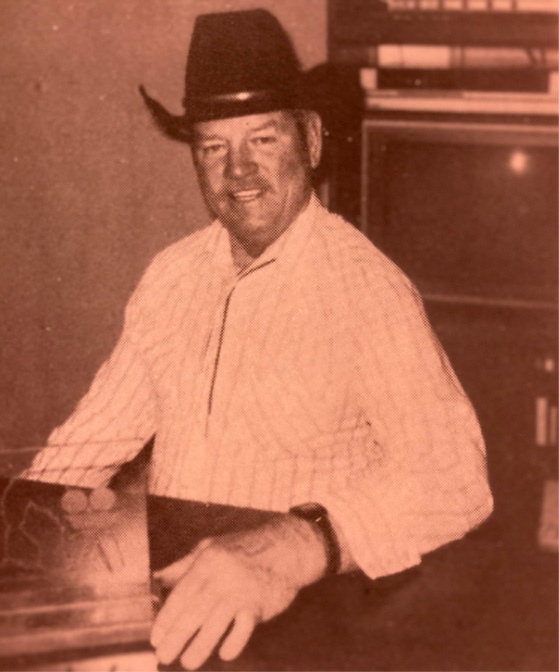
But Karl Tangren, ever the optimist, and a man who is always eager to make a silk purse from a sow’s ear (or a cow’s!), decided to make the best of the situation. Eventually he obtained permits to offer horseback rides in Canyonlands, and he led land tours and raft trips for Tag-a-Long when Mitch Williams was its owner.
Still, getting crosswise with the federal government was a painful nd frustrating experience that lingered with Karl and many others. I found out first hand one morning, when I was washing my clothes at the old Speed Queen Laundromat in the Miller Shopping Center. Sitting next to me was Karl. He didn’t know me from Adam, but even 30 years ago, everybody knew who Karl Tangren was. In addition to his own lifelong connection to Moab and the fact that his family’s Moab history tracks all the way back to the 1870s, Karl Tangren probably has the best, most memorable, and distinctive laugh of anyone I’ve ever known. One day I was at the Moab Diner with a friend of mine visiting from Kentucky. Suddenly, from across the diner, I heard “The Laugh.” I chuckled and said to my visiting friend, “Well, it looks like Karl Tangren took a break from the Branding Iron today.” (Karl started the Branding Iron restaurant in 1989).
“How do you know that?” my buddy asked.
I said, “Nobody laughs like Karl Tangren.”
Now, as we sat side by side at the laundromat, waiting for the spin cycle to end, Karl started chatting with me, assuming I was just a tourist passing by. I told him I had lived in Moab for almost ten years, and suddenly it was almost as if that made us brothers. He could not have been friendlier until he asked me what I did for a living. When I replied I was a ranger with the National Park Service, his smile vanished in the blink of an eye. He stared at me coldly and said, “Well, I don’t have much use for the federal government. I think they’re ruining this canyon country when they claim they’re trying to save it. And they don’t give a damn about us folks who have been here for generations. My family has been here for a hundred years but do you think they care? Hell no.”
I was fast approaching the end of my own Park Service career and was getting out for reasons very similar to Karl’s. So I explained my own feelings about the federal government –its rigid, mindless bureaucracy, its lack of humanity at times. And for sure, its insensitivity to the history of the area. When I told him that almost every NPS staffer at Arches and Canyonlands headquarters above the GS-9 pay grade was praying for the day when I’d quit and stop being a nuisance to them, Karl broke out laughing and said, “Well… maybe you’re not such a bad kid after all!”
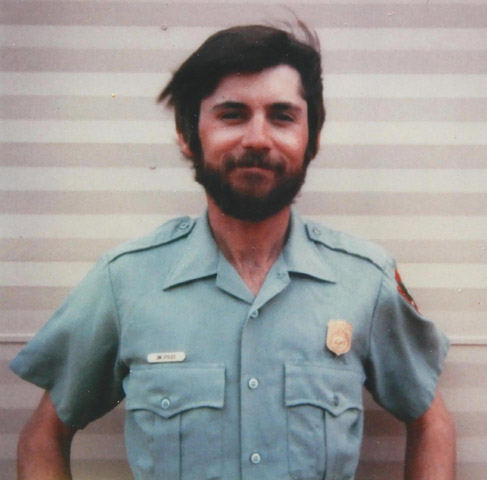
We talked all the way through the spin cycle and long past 75 cents worth of dryer time. He told me about his Anderson Bottom clash and it seems to me there was another SITLA fight that one of his brothers waged with the Park Service as well. And he talked about Bates. Despite the conflict and his disappointment, Karl said, “Ah Hell, I know he was just doin’ his job. Me and Bates had been friends for years. In fact, when I first heard about Canyonlands, I was all for it. And I even went and talked to Bates about maybe signin’ on as a ranger. Especially on the river. I told Bates, ‘I’ve run that river in everything from a rubber raft to a bathtub. I even floated my cows across the river on a raft I built myself. I think I’d do a good job for you fellas.’”
Karl told me that Bates was sympathetic and knew that Karl could do the job better than anyone he could think of. “But then,” Karl went on, “Bates told me the Parks people have this requirement… you got to have a college degree to really go anywhere in the Park Service. Even as a seasonal ranger. I said to him, ‘What the hell does a college education have anything to do with bein’ able to run the river? Most of those kids wouldn’t know which end of the paddle to stick in the water.’ Bates agreed with me and I could tell he felt bad just tellin’ me, but those were the rules.”
Karl gave up on the idea but still found a way to share his knowledge with visitors to the canyon country, via his horse ride tours and river trips. And he continued to maintain his sense of humor and his unforgettable laugh.
After 51 years he finally stepped down from the Film Commission, but still stayed active. His knowledge of the Canyon Country is still honored and appreciated, and for years, one of the tour companies hired him to accompany a bus load of tourists out to Grandview Point. His only job requirement was to talk and tell stories. Nothing comes easier to Karl Tangren than telling tales, and so for years, once a week, he’d make the ride and tell his stories. It was often the highlight of their trip.
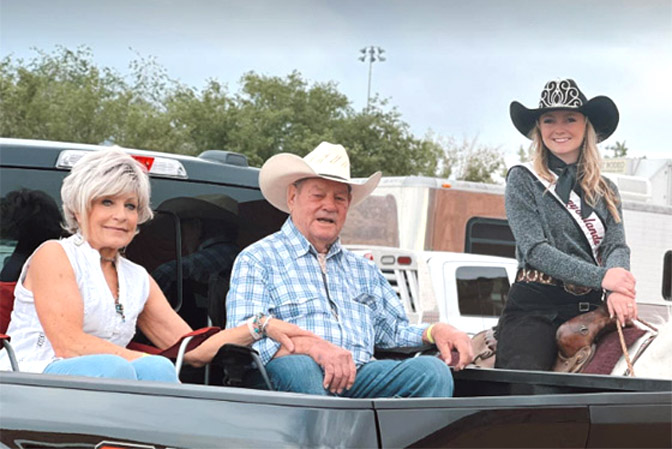
2022 Canyonlands PCRA Rodeo. June 2022
Then last June, Karl was honored by the Canyonlands PRCA Rodeo, when he was named Grand Marshal of the event. The Professional Rodeo Cowboys Association is the largest rodeo association in the world and has been around for almost a century. Karl and his wife Joylyn loved every moment of it. For so many of his friends, it was inspiring to see him receive the recognition he has deserved for so long.
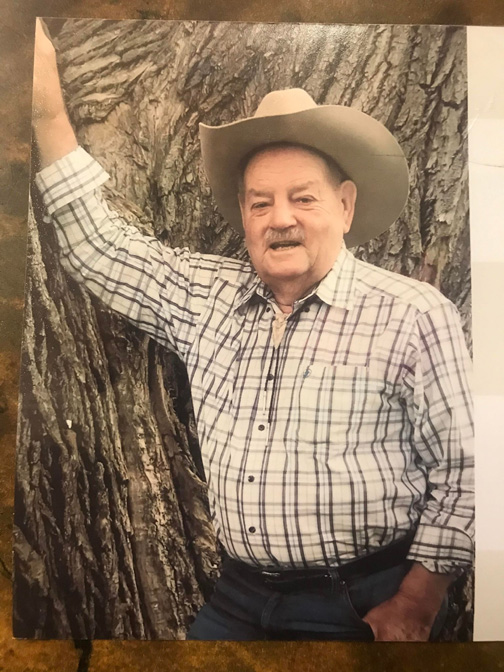
*****
Lifelong resident Kathey McNeeley met up with Karl last week and asked him about those bus rides. Karl remembered that, “I never had to make anything up. I’d just tell them the stories of my life. They’d ask me a question and I’d tell them my stories. I did that every Saturday for years. I run cattle in that country since I was 13 years old. I built half the trails out there, I and my brothers. So that was a big part of my life. I’ll always remember and I’m glad I had the opportunity to do it.
Kathey talked with Karl at his favorite cafe, the Branding Iron, just south of town. He eventually turned it over to his daughter, and now finally the Tangrens sold it. But it’s still his favorite place to gather with friends and talk about their lives and the parts of it they treasure most. What does Karl think of Moab now, in 2022? Here are some of his observations…
“Well…I don’t know what to tell you. I’ve lived here for 91 years now, and seen a lot of things happen in this town. And the best years of my life, best spent in Moab, was in the 1940s and 50s. It was just a laid back, home town. And everybody knew everybody. If you needed help, your neighbor was there to help you. Today you go to town and there’s thousands of people and you don’t know any of them. Runnin’ around like a beehive. Can’t get up and down the street like you want to.
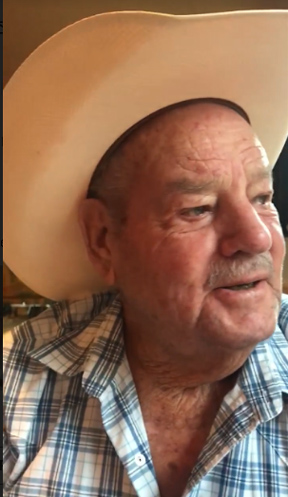
“So yeah, I liked it a lot better back then than I do today,. The town has changed so much and grown by leaps and bounds. If you find somebody you know, it’s hard to get them to stop and talk.
“When you’re 91 years old, there isn’t a lot more that you can do except enjoy the past, and I’m glad I still remember. So about every day I meet friends here at the Branding iron, which I built in 1989. On Wednesdays we always come here to reminisce a bit. So coming here to the Branding Iron is a big part of my life now. I can’t get out and do much else.
“The other day, I was tellin’ stories and some guy said to me, ‘What haven’t you done, Tangren?’ and I said, ‘I don’t think I ever herded sheep. I’ve done about everything else I can think of.
With his birthday coming up and a big party planned, Karl said, “Well, I just hope it don’t rain because it’s an outside deal,” but it was just like Karl Tangren to see the best in anything. He added, “but if it does, we’ll just sit back and enjoy the rain.”
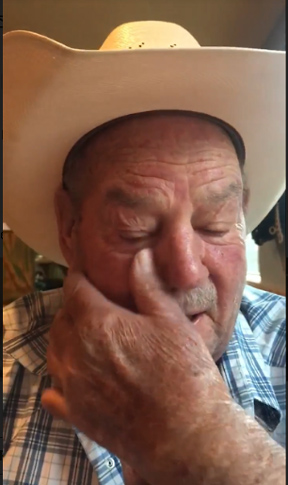
Happy Birthday, Karl Tangren. You’re as much a part of Moab as the red rocks themselves. And you always will be.
POSTSCRIPT: I’ve always regretted that I didn’t get to know Karl better. But when Kathey McNeely approached me about writing a story, I was honored to give it a try. I am especially grateful to Kathey for taking the time to interview Karl. It’s just what the story needed–words from Karl himself.
But I know this account is incomplete and I would love to hear more. There are so many of you “old Moabites” who must have Karl Tangren stories, and I hope you will take the time to share them with The Zephyr, either in the comments section at the bottom of this page, or as a comment on the Zephyr Facebook page.
Thanks…
Jim Stiles
TO COMMENT ON THIS STORY, PLEASE SCROLL TO THE BOTTOM OF THIS PAGE.

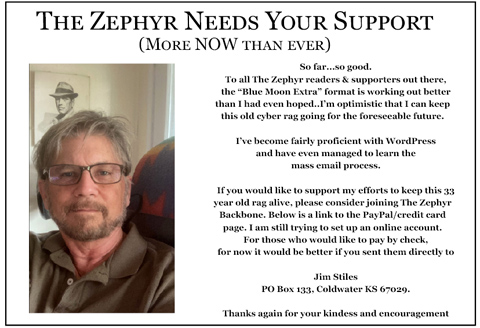
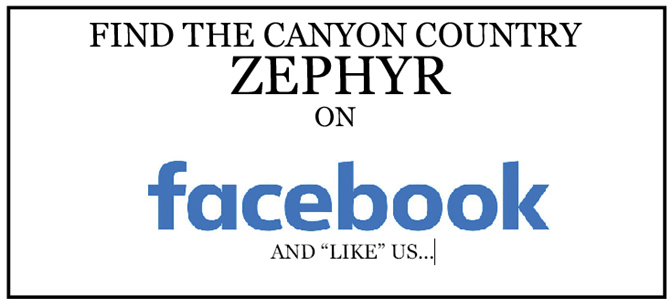

https://www.mazzacafe.com/
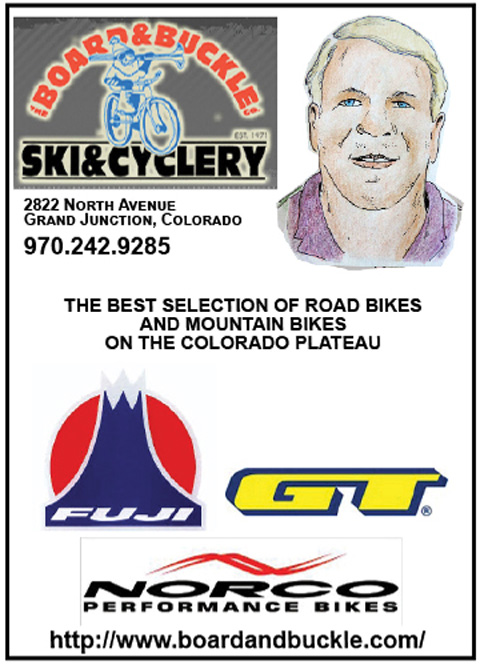


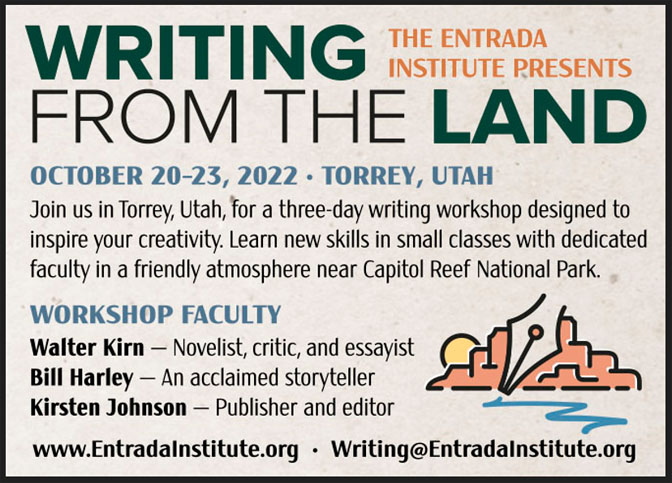
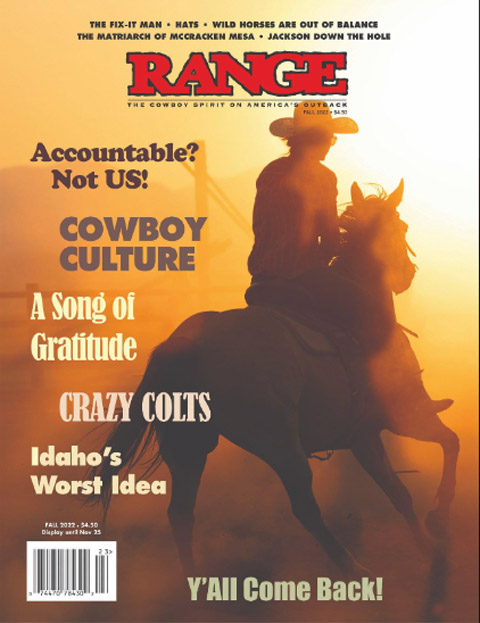
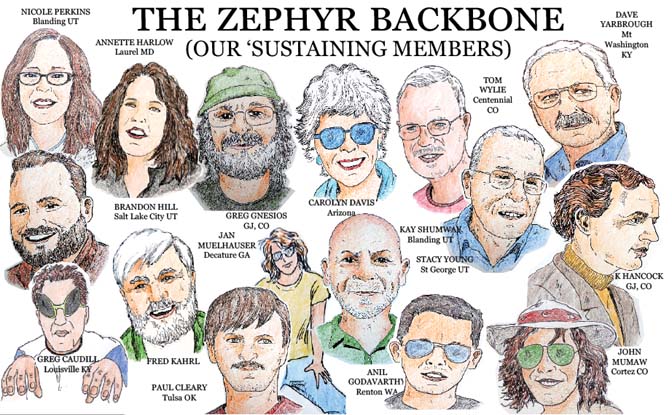
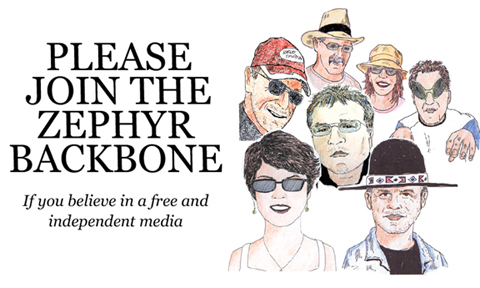
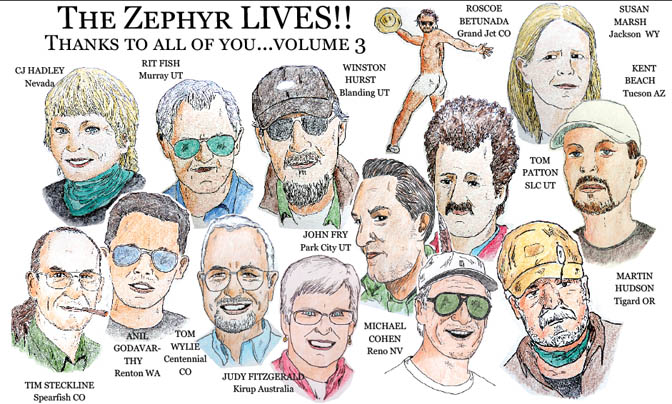
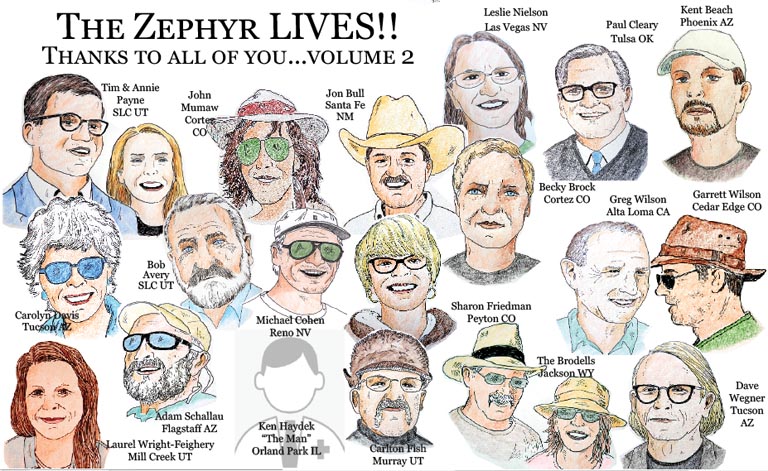
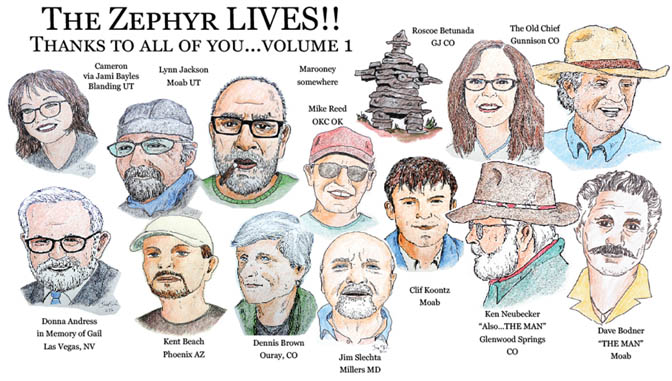
Thanks Jim
Thank you Jim for a beautiful story, Karl is amazing.
Excellent history and a wonderful profile of a man that lived a big part of it. I love these stories and they brighten my week when I read them. I can see the times and the people that you are writing about clearly as though they are happening at the moment. Thank you.
One day my dad Curtis young and my self were headed out to the desert to punch cows like every morning we stop at the maverick for gas.
We had a big black and white paint horse named Leroy, and she was big and round I mean she was fat
We had her and another horse in the back of our pickup , and my little kid saddle was on Leroy the saddle was small ( I was probably 6 or seven) and the stirrups stuck straight out on ole Leroy. We walked into the maverick and Karl’s big booming voice said dang Danny that saddle looks like a postage stamp up there on old Leroy !!!!
Oh Jim
Yet another subject close to my heart!
Karl’s first wife was my mother’s niece and we all lived on
the same block, those were the good days, we were a rowdy bunch for sure. Their house was on 300 south and Karl had his horses for his trail riding business there. I think of many times it was flooded out. My sister and brother along with the Dull boys ran with Butch and Susie, what a group they had. I’m sure I drove Karl absolutely crazy because I was always there asking to ride. There’s several times I rode up through the trail behind the grand old ranch house on one of his many trail rides. To this day he still addresses me as “Bob”, he’s always been dear to my heart as he is most of the town. He’s one in a million that’s for sure.
Happy birthday Karl .
Dear Jim,
Thanks for a very timely article about a great man in the good old days. I grew up in the 40’s and 50’s. This article describes the progression from then to now, and how and why all things have changed, how fine people have survived the government overreach then and now. His spirit and yours make a difference for everyone. Times change, but good people like you and him keep the precious memories alive. You and him make the world a better place in spite of everything.
Kathleen
What a guy! What a neat story,Jim. Thank you for not forgetting those who lived in the best of times! Most sincerely, Donna
God certainly broke the mold with Karl 😂
He and my grandpa Kay are first cousins and share a rich family history! You always hear Karl’s big booming voice and laugh long before you spot him! There aren’t many storytellers quite like Karl and I love chatting with him whenever he pops up at my office and always give him a hug. Karl loves to hug all the pretty girls!
He was born EXACTLY 30 years before Me!
Great Story
Thank you Jim for a wonderful story! Karl is like a second dad to me and my wife and I think the world of him and Joy Lynn. I do have to bring to light one mistake in your story. My Mother and Dad operated the little two pump gas station which later morphed into what it has become today. Mother came up with the name Maverik because it was an independent unbranded station. Hence the name Maverik or unbranded calf. When I stopped in there a few years ago for gas I asked those kids if they knew how the name came about. They proceeded to tell me they watched a training video for new hires and in it they learn the name came from the old TV series Maverik. Nothing could be farther from the truth. When Karl bought the lease from my dad in 1959 the sign Maverik was already there although much smaller and it was just a simple gas station. Karl traded a Massey Ferguson tractor to Dad as part payment and I used to go out and play on it when Dad was at work. Dad had that same handshake agreement with the gas supplier and that was with Reuel Call who owned Caribou Four Corners Oil Company out of Afton, Wy. Dad and Reuel remained lifelong friends. I remember when I first met Karl and his first wife Patsy as a very young boy. Great memories of growing up in Moab. God bless you Karl, Christine and I wish you a wonderful birthday! P.S. I bought a box of 20 birthday cards so you’re going to have to hang in there until you’re 111 years young!
An archetypal “Hopelessly clinging to the past” article, and that’s a good thing. Thank you for your perseverance in keeping this spirit alive with the Zephyr’s gems. Plaudits.
Great story … Karl was one of the very first people I met when we moved here in the mid 1960’s. I would like to have seen some inclusion about the development of the house in the rock wall and other rooms below the potash evaporation ponds along the Colorado River.
Hi Dee. Thanks. I didn’t know enough about it on my deadline to include that part of the story. Anything you or others can add here would be great.
Jim
Carl has some Shafer Basin-Shafer Trail stories.